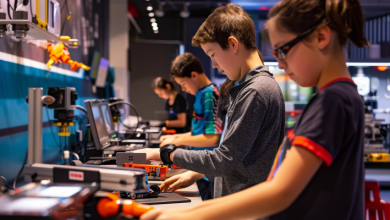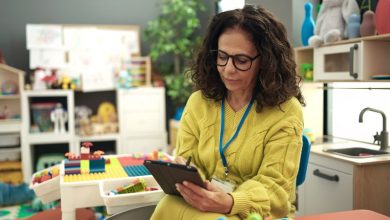Understanding how collaboration technology is driving a teaching transformation

 Previously we discussed how virtual learning using video collaboration allows us to create the classroom of the future while still delivering a personal face-to-face experience.
Previously we discussed how virtual learning using video collaboration allows us to create the classroom of the future while still delivering a personal face-to-face experience.
I would now like to look at the impact technology is having on classroom dynamics and more specifically, the way we teach, to ensure our students will be equipped to enter the future workforce.
Carolyn Bennett, e-principal at FarNet and Polycom customer said: “Once they [teachers] have experienced online teaching we see them taking what works back into their face to face classes. This is where we are seeing truly powerful learning and collaboration as teachers stop seeing themselves as deliverers of information. They release this control, letting students learn in a more blended environment. Students and teachers are collaborating and learning together which creates a higher trust environment.”
So how well are teachers adapting to the digital classroom? What constitutes best practice pedagogy in a technology enabled world?
According to New Zealand’s Minister for Education, over 95% of New Zealand schools have now signed up to use the government-funded Managed Network, giving them fast and reliable internet access and uncapped data.
A significant step in ensuring schools have the necessary infrastructure needed to embrace digital technologies to their fullest potential in the classroom. More internet means more educational opportunities, greater communication options and reduces the distance between two points.
With internet for everyone, one of most rapid changes we are seeing in classrooms is the power of connectivity and its impact on teaching and learning dynamics. Today students can connect with their teachers and fellow class members anytime, anywhere. This could mean connecting in from a tablet, from a smartphone, from a conference room, from a classroom, from a lecture hall and this is only going to increase.
This increased connectivity promotes more interactions, content sharing and engagement among instructors and students, key in today’s learning environment.
Cultivating higher-order thinking and creativity
We all know that face-to-face teaching remains important. One-to-one is as well. But the key question we must be asking ourselves is the traditional face-to-face teaching method still relevant in today’s blended learning environment?
I’m not saying lose the ‘blackboard’ altogether, but this style of teaching does endear itself to a ‘sit and get’ environment with the teacher centre stage and little interaction or collaboration. I really believe that by adopting a more collaborative style of teaching we can help students cultivate a higher level of thinking and creativity.
Improving teaching and learning experiences can engage students with high-impact and interactive learning experiences that provide better access to knowledge and expand curriculum portfolios. Student learning spaces can be transformed through video collaboration with project-based learning, virtual guest speakers or field trips and collaborative partnerships.
Yes, traditional teaching has it good points, but it was designed to prepare students for jobs that are disappearing. Jobs of the last century. Sitting in rows, doing rote learning….even the bell between classes was originally designed to get students in a habit of working on repeat processes and knowing when to take a break. It prepared them for rote jobs in an industry or on a manufacturing floor or at a desk. It does not promote higher order critical thinking skills or encourage students to think differently and be creative. Today, we have to prepare students for jobs that demand these skills.
Educators need to accelerate the demand for a broad and rounded knowledge base that equips citizens with skills for a new economy. Core Education recently identified 10 key digital technology trends, within key areas of change that are impacting all aspects of education in New Zealand.
One of these key areas of focus is learner orientation and the idea of designing learner-oriented systems built around the learner, rather than the learner being required to fit with the system.
A learner-oriented approach is also being seen in the development of modern learning environments, where more flexible, multi-use and purposeful spaces are being created, replacing the traditional ‘egg-crate’ classroom, built to a common specification regardless of whether it is catering to a group of five-year-olds or 12-year-olds.
At Polycom, we believe that the happy medium is creating an on-demand collaborative learning environment. Being able to do this outside a traditional classroom, using video collaboration with geographically dispersed students and teachers is priceless.
Understanding the virtual classroom approach and how it enhances learning
As I have touched on previously, a virtual classroom is where the teacher and students are logged into the virtual learning environment at the same time seeing each other face to face. It also means you have the flexibility to connect from a remote site using a tablet, smartphone, classroom or other location.
I often call it a virtual meeting room (VMR) as it expands our classroom walls and allows students to connect with students, experts and teachers based at remote locations.
One of the biggest advantages to adopting this technology based teaching approach is that you have the flexibility to bring anyone into a virtual classroom. For example, if you teach music, you could invite a guest pianist to join the class remotely and share this learning with all participants. And it is wonderful to see the collaboration between the students themselves, taking ownership for their learning which creates a highly interactive and engaging environment.
Students also up their game when they are learning with technology as it gets them excited about learning. It’s a different way to learn but there’s a lot of success.
Collaborative clusters – gaining traction
Collaborative clusters is another teaching method that is gaining ground quickly. As an educator teaching a specific class, I can now record a session prior to the scheduled class, allowing me to set the stage for what will happen in that specific class environment. With lecture capture, students are no longer limited to in-class experiences. They can view recorded lessons anytime, anywhere from the convenience of their mobile device.
Having viewed the lecture, when students meet in my class, they may then break into cluster groups and go into their own virtual meeting rooms to collaborate on a specific topic. This allows me as their educator to spend more one-on-one time with them working on group projects, completing homework and participating in more in-depth discussions — all during class time. I can then use different technologies like a smartphone or tablet as a back channel to engage with students, working with them in their virtual meeting room or they can request help or invite me to join their discussion.
When teachers get it right, Collaborative Clusters promote interaction and content sharing and engagement among students. They also provide flexible access to collaborative environments, enabling access to distance learning opportunities that students would not normally have. This type of teaching is exciting and it gives students access to anytime anywhere learning.
What does the future hold?
Our students are living and working in a digital world. Schools must do their part in providing students with the tools to make their learning experience up-to-date, engaging, and effective. To succeed in the ‘workplace of the future’, it is important that students have critical thinking skills, understand how to work in geographically dispersed teams, how to problem solve and how to communicate.
It’s clear that video collaboration and online access are changing the way students learn. Teachers can now use their classroom time to lead activities and discussions that drive home the subject matter in a more memorable and engaging way. Distance learning can provide students with access to experts and experiences across the globe while minimizing the limitations of cost, time, and travel.
Education institutes and providers need to recognise this demand and provide an interactive, innovative and collaborative learning environment that makes people want to continue learning and set them up for future success. Education technology isn’t a “nice to have” anymore —it’s critical to the success of all students throughout their education.
Elaine Shuck, with a background in technology, curriculum, and integration, is the director of education, U.S. Public Sector, for Polycom. She is a leader in collaborative learning and interactive videoconferencing. For almost 20 years she has brought stimulating and engaging learning opportunities to K-20 classrooms. Elaine works with a host of educational groups and is currently the President of the United States Distance Learning Association (USDLA).
References
1. NZ Government: Most Schools Signed Up to Managed Network
2. Core Education: Ten Trends 2015
3. Core Education: Learner Orientation








